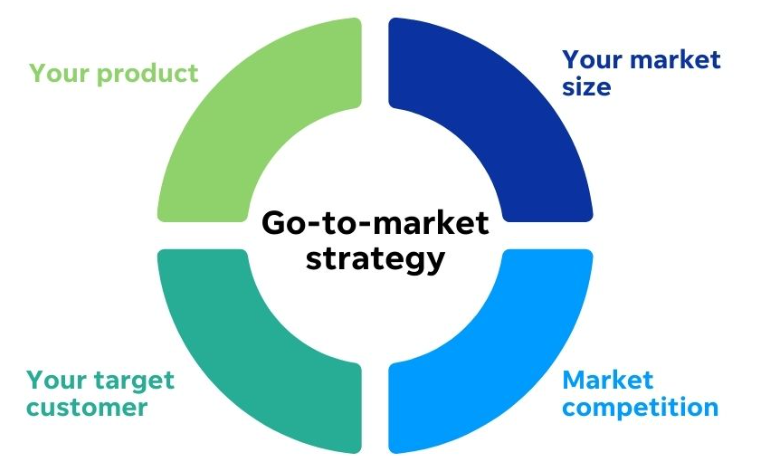Have you ever played a game of chess? Each part, having its one-of-a-kind capacity to move and strike, is a fundamental piece of the general plan. A go-to-market (GTM) strategy is not much different. It’s like having your own set of chess pieces – each representing various components such as target audience identification, product-market fit analysis, or marketing plan creation.
Your success depends on how well you play these pieces – positioning them right and moving at the correct time. If you’re new to this “game” or just need some guidance, fear not!
You’re in for a treat with this guide, it’s packed to the brim with insights that’ll help you grasp GTM basics, create effective buyer personas, pick marketing channels like a pro, align your sales strategies for maximum impact, plan product launches successfully and learn from real-world examples. Plus, we’ll also dive into how to manage and optimize your approach.
Understanding Go-to-Market Strategy
The go-to-market (GTM) strategy is a roadmap designed to help businesses deliver their unique value proposition to customers effectively and efficiently. A successful business model is incomplete without a GTM strategy.
This plan aims to identify the ideal customer, comprehend their pain points, and align your product or service as a solution. The GTM strategy helps define not only who your target audience is but also how you will reach them through effective marketing channels.
A go-to-market strategy can be considered successful when it enables demand generation by attracting potential customers towards the brand or product while minimizing customer acquisition cost. Understanding this concept fully lets companies better manage expectations during product launches.
Fundamentals of GTM Strategy
An effective go-to-market plan begins with understanding buyer personas and developing an accurate customer profile. This knowledge aids in defining your market strategy based on what appeals most to these target customers, thereby increasing conversion rates.
To ensure relevance in today’s digital age, businesses need to include social media strategies within their overall marketing plan for boosting brand awareness. Moreover, content marketing has emerged as a powerful tool for drawing inbound leads that may translate into sales over time.
In essence, this involves creating educational content aimed at addressing key pain points which the targeted product solves. The aim here is grabbing the customer’s attention while simultaneously building robust customer relationships – critical aspects of inbound marketing strategies.
GTM Strategy Framework: A Detailed Plan
The crux of any GTM framework lies in its detailed nature; outlining everything from pricing structures catering specifically towards identified buyer personas right up until managing end-user feedback post-launch allows organizations maintain control over entire market process.
Part of the strategy is offering free trials or demos to potential customers. This tactic gives them firsthand experience with what your product brings to the table, helping build a strong business case while generating awareness about your brand.
A successful product launch depends heavily on such methods since they help in testing products before spending money for full-scale deployment.
Key Takeaway:
Understanding your go-to-market (GTM) strategy is like drawing a roadmap to customer happiness. It’s about identifying your target audience, figuring out what they need, and showcasing your product as the answer. By skillfully using marketing strategies such as social media buzz and creating engaging content, you can enhance brand recognition and forge solid relationships with customers. Don’t forget – nothing beats this.
Analyzing Market and Competition
Launching a successful go-to-market (GTM) strategy hinges on your ability to understand the market landscape. This includes getting familiar with the target audience, gauging competition, and defining product-market fit.
Identifying Target Audience and Buyer Personas
To accurately identify the target audience, it is important to consider factors such as job titles, pain points in business processes, and lifestyle habits that may influence buying decisions. Consider factors like job titles, their pain points in business processes, or even lifestyle habits that influence buying decisions.
Buyer personas take this further by creating detailed profiles of potential customers. Understanding buyer personas helps ensure marketing efforts align closely with consumer needs while maximizing conversion rates.
The best GTM strategies involve thorough competitor analysis. What is their unique selling proposition? How does your product solve problems differently or more effectively than theirs?
Finding Your Product-Market Fit
Achieving a strong product-market fit involves crafting solutions that not only resolve identified pain points but also stand out from existing offerings in the market. Essentially it’s about making sure what you offer isn’t just needed but preferred too.
This requires testing the waters before spending money on full-scale production and launch plans – part of the demand generation process really. It’s better to fail early at little cost than later when much has been invested into scaling operations for mass consumption.
Diving Deep Into Competitive Analysis
Competitive analysis, another crucial aspect of any GTM plan template, should delve into various aspects including competitors’ product features compared against yours as well as understanding how they are engaging with their own target audiences.
Remember, the key to a successful GTM strategy is understanding your customer and competition alike. This insight will let you position your product effectively in the market.
A Quick Note on Existing Markets
Breaking into an existing market can be challenging but rewarding if done right. Your business case needs to convince potential customers that your product brings more value than current solutions they are using.
Key Takeaway:
Master the Market: To nail your go-to-market strategy, dig deep into market and competitor analysis. Understand who your target audience is, their pain points, buying habits, and how you can offer a better solution than competitors.
Power of Personas: By shaping detailed buyer personas, we can better match our marketing strategies with customer needs for enhanced results.
Crafting a Marketing Plan for GTM Strategy
Your go-to-market (GTM) strategy is only as good as the marketing plan supporting it. It’s like having a sports car but no fuel to power it – you’re not going anywhere fast. So, let’s talk about crafting an effective marketing plan that drives your GTM strategy forward.
Building Customer Relationships through Content Marketing
The key to successful content marketing is understanding and connecting with your buyer personas. It involves creating relevant, valuable content that resonates with their pain points and needs. The right mix of content can help build strong customer relationships, much like cement holds bricks together in a wall.
Monday.com CRM platform can be used to track these interactions and further strengthen these bonds by offering personalized experiences based on user data.
Selecting Appropriate Marketing Channels
A well-rounded GTM strategy leverages both direct and indirect channels for product distribution. This could include social media platforms or email campaigns targeting specific job titles within target companies. But remember: spreading yourself too thin over many channels without seeing results isn’t wise; focus on what works best.
Leveraging Social Media for Brand Awareness
Social media provides excellent opportunities to increase brand awareness among your ideal customers because they spend significant time there daily. Engage them where they are – think Facebook ads showcasing how effectively your product solves common issues or LinkedIn posts detailing key benefits of using your solution.
Inbound Strategies & Lead Generation:
Incorporating inbound strategies into our marketing plans, we attract potential customers with valuable content. It’s like throwing a party and inviting everyone who loves the same music you do – you’re more likely to get along. Lead generation strategies include offering free trials or educational resources in exchange for contact information.
Lastly, don’t forget that your GTM strategy is not static; it needs regular check-ins and tweaks based on data-driven insights. Keep an eye on conversion rates, customer acquisition cost, and brand awareness metrics to ensure success.
Key Takeaway:
Power your go-to-market strategy with a solid marketing plan, focusing on building customer relationships through content that hits home. Choose effective distribution channels wisely and use social media to boost brand visibility. Inbound strategies are crucial for lead generation, but remember: regularly review and tweak your GTM approach based on data insights.
Sales Strategies in Go-to-Market Execution
Mastering the sales cycle is crucial for a successful go-to-market (GTM) execution. It’s about more than just selling; it involves understanding and aligning your sales strategies with marketing teams to achieve optimal results.
Understanding The Sales Cycle
The sales cycle, from prospect identification to closing the deal, varies across industries and products. But there are common steps involved: lead generation, initial contact, needs assessment, proposal presentation, handling objections if any arise before finally closing the sale.
An efficient sales team can help shorten this cycle by properly identifying potential customers’ pain points and presenting tailored solutions that meet their specific needs.
Navigating Common Sales Strategies
Different markets need different approaches – what works in one might not work in another. There are various common sales strategies used depending on product type or target audience demographics like consultative selling or solution selling where you focus on solving customer’s problems rather than pushing for a product sale outrightly.
The Challenger Sale strategy, popularized by Matthew Dixon and Brent Adamson’s book of the same name suggests that reps should challenge customers’ preconceptions about their business issues leading them towards valuable insights instead of simply meeting their stated requirements. This proactive approach positions you as an advisor making it easier to close deals.
Aligning Sales And Marketing Teams For Optimal Results
A well-coordinated dance between marketing teams who generate inbound leads via content creation campaigns & SEO efforts alongside an agile & informed sales team is key to winning over new clients effectively.
This collaboration helps create targeted messaging which resonates with ideal buyer personas, increasing conversion rates.
Optimizing Customer Acquisition Cost
With the high stakes of customer acquisition costs (CAC), it’s critical to fine-tune every step. Look at how HubSpot’s tiered pricing strategy lets businesses effectively handle their CAC.
Key Takeaway:
Getting a grip on your sales cycle is crucial for an effective go-to-market strategy. This isn’t just about making sales, but also syncing with marketing to achieve top-notch results. Get to know what your customers want and customize solutions that hit the mark. Different markets might call for unique strategies, so stay flexible. A seamless blend of inbound leads from marketing drives and a nimble sales squad can do wonders.
Product Launch and Go-to-Market Execution
A successful product launch is more than just getting your product out there. It involves testing, creating educational content for customers, generating awareness, and even offering free trials or demos.
Planning the Product Launch
Your product’s debut in the market should be planned meticulously to ensure a smooth rollout. From finalizing pricing strategy with consideration to target customer personas and product-market fit, all elements need careful thought.
You also want to keep track of your conversion rates throughout this process as they provide valuable insights into how well you’re reaching your audience.
Testing Your Product
Prior to launching, it’s critical that you test your product thoroughly. This helps identify any potential issues early on before they reach the end-user which could harm brand perception or result in unnecessary costs down the line.
Educational Content Creation
In order to engage effectively with prospective buyers during go-to-market execution, develop relevant educational content about what problem(s) your product solves. The key here is relevance – understand their pain points intimately so you can address them directly through meaningful content creation strategies like blogs or social media posts.
Demand Generation: Creating Awareness & Offering Free Trials/Demos
The power of word-of-mouth marketing shouldn’t be underestimated when trying to generate awareness around a new launch. Encourage happy customers from earlier tests or betas if applicable – nothing beats authentic testimonials.
Finally, consider giving away some free trials/demos; people love being able to try something without committing immediately.
Giving potential customers the opportunity to try your product without having to commit right away can be beneficial in creating a trusting relationship with them, as well as demonstrating how it could help.
Ready to take your product from the workshop to the world? Remember, a stellar launch involves careful planning, robust testing, crafting meaningful content and generating buzz with free trials. It’s not just about making it – it’s how you introduce it. #ProductLaunch #GoToClick to Tweet
Go-to-Market Strategy Examples
If you’re seeking a little inspiration, we’ve got some remarkable go-to-market (GTM) strategy examples for you. Let’s look at Dropbox and how they used an innovative customer referral program to explode their user base.
Dropbox: Mastering Referral Marketing
Dropbox’s referral program is one of the best GTM strategies out there. This simple but genius plan helped them gain millions of users in a short time span. By offering extra storage space as a reward, Dropbox was able to encourage existing users to refer new ones.
This approach effectively addressed two key pain points: the need for more storage space and acquiring new customers without blowing up their acquisition cost.
A Successful Product Launch Through Testing & Awareness Generation
The foundation of any successful product launch lies in testing your product thoroughly before it hits the market and generating enough buzz around it so that people are aware of its arrival. Time spent on building these elements can save you from spending money on damage control later down the line.
Demo versions or free trials work wonders here by grabbing potential customer’s attention while also providing them with firsthand experience about what your product brings to the table.
Pivoting Towards Your Ideal Customer Profile With SWOT Analysis
In this ever-changing business landscape, being static could be lethal. Adapting your marketing plan according to changes in buyer personas or shifts in market trends helps keep your brand relevant.
You may have started with a particular ideal customer profile; however, conducting regular SWOT analysis allows us to stay updated with our evolving target audience. For instance, if you find that a significant portion of your inbound leads are coming from job titles outside your original target, it might be time to revisit and expand your buyer personas.
Learning from these strategy examples and applying them effectively can lead to impressive results. Just remember, there’s no one-size-fits-all GTM plan template; each business model requires its unique approach.
Key Takeaway:
Learn from Dropbox’s successful go-to-market strategy: use a customer referral program to grow your user base. Before launching, test your product and generate buzz. Always be ready to pivot and adapt your marketing plan based on shifts in market trends or changes in buyer personas. Remember, there isn’t a one-size-fits-all solution – each business needs its unique approach.
Managing and Optimizing Go-to-Market Strategy
The secret to a prosperous business is the capacity to adjust, understand, and progress. This holds true when managing your go-to-market (GTM) strategy as well.
Tracking Metrics & KPIs
A key part of managing any GTM strategy involves tracking metrics and Key Performance Indicators (KPIs). But it’s not just about collecting data; you need to interpret this information correctly too.
You can use tools like Monday.com CRM platform for tracking various metrics such as conversion rates, customer acquisition cost or even brand awareness. These numbers give insight into how effective your current approach is and where adjustments might be needed.
Adapting to Market Changes
In today’s fast-paced world, trends change quickly. Businesses that fail to adapt risk being left behind by their competition. It’s crucial then that you keep an eye on changes within your existing market space so you’re always ready with an updated GTM plan.
To help stay ahead of these shifts, consider subscribing to industry news feeds or setting up Google Alerts for keywords relevant to your sector – all useful strategies for staying informed about potential disruptions before they happen.
Maintaining a Dynamic Business Model
An integral part of optimizing a GTM strategy is ensuring the flexibility of your business model. Your initial product-market fit may evolve over time due to external factors such as emerging technologies or shifting buyer personas.
In fact, according to LinkedIn’s free e-book on go-to-market strategy, Dropbox changed its referral program structure multiple times before finding what worked best.
Continuous Improvement
A well-managed GTM strategy is never set in stone. It requires continuous testing, analysis, and iteration for improvement.
Take a cue from HubSpot’s tiered pricing strategy. They regularly analyze their customer acquisition cost and conversion rates to make sure they are getting the most out of every marketing dollar spent.
Scaling and Expanding the Strategy
Getting to that sweet spot of success
Key Takeaway:
Running a successful go-to-market strategy means being ready to adapt, learn and improve. This involves tracking metrics with tools like Monday.com CRM platform, staying aware of market changes via industry news feeds or Google Alerts, ensuring your business model can flex with changing circumstances and continually testing and iterating for better results.
Conclusion
Stepping into the world of a go-to-market strategy can feel like stepping onto a chessboard. But with this guide, you’ve gained insight on how to move and position your pieces effectively.
Your target audience isn’t just out there waiting. You learned how to identify them, understand their pain points, and create ideal customer profiles that resonate.
You discovered strategies for aligning marketing channels, leveraging social media for brand awareness and optimizing content marketing efforts. These are key steps in crafting an effective GTM plan.
Sales aren’t accidental either! With understanding common sales techniques, managing acquisition costs effectively and balancing your sales team dynamics – victory is closer than ever!
Lastly remember: Your product launch should generate buzz but also offer real value. And learning from successful GTM examples can help pave the way towards success while avoiding potential pitfalls along the journey!
If you want to learn more about this, sign up for my newsletter.


